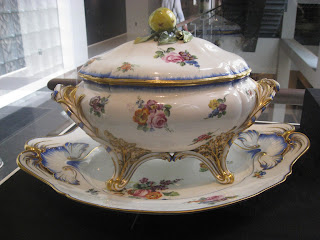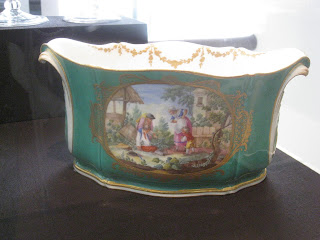General George Washington oil on canvas circa 1779 attributed to Charles Willson Peale.
Whimsical porcelain figures, enchanting miniature portraits, and a dazzling array of historical glass have been among NOMA’s visitor favorites for decades. The museum is pleased to announce that the Lupin Foundation Decorative Arts Galleries on the second floor are reopening with a reimagined installation. In a series of gallery unveilings through 2017 and 2018, and with the creation of the Elise M. Besthoff Foundation changing gallery, NOMA will celebrate its beloved collection of design, craft, and ornament. These new installations carry forward a curatorial initiative to integrate collections across material and culture, to provide layered interpretation, and to present the best of our Gulf region’s artistic expression in context with our encyclopedic collection covering ancient to contemporary arts.
English, for Chinese Market, Automaton Musical Clock, c. 1790, In the manner of James Cox, Ormolu (gilt bronze), Guilloché enamel, paste jewels, and metal movements; 28 1⁄2 in. high, New Orleans Museum of Art: Bequest of Mr. and Mrs. Robert C. Hills, 2001.253.369
When the first of the Lupin Galleries opened on March 16, for the first time the finest of NOMA’s more than 10,000 pieces of ceramics, glass, furniture, silver, and portrait miniatures were installed together with fine arts. This new presentation highlights connections — between glass vessels and mahogany furniture, between European and American designs, and between tiny portrait miniatures and monumental silver centerpieces. With an installation that looks both deeply and broadly at 18th- and early 19th-century design and art in both America and Europe, the first of the Lupin Galleries focuses on NOMA’s foundational collections in the decorative arts — the Kuntz family collection gifted in 1979 and the Billups glass collection gifted in 1955.
English, for Chinese Market, Automaton Musical Clock, c. 1790, In the manner of James Cox, Ormolu (gilt bronze), Guilloché enamel, paste jewels, and metal movements; 28 1⁄2 in. high, New Orleans Museum of Art: Bequest of Mr. and Mrs. Robert C. Hills, 2001.253.369
English, for Chinese Market, Automaton Musical Clock, c. 1790, In the manner of James Cox, Ormolu (gilt bronze), Guilloché enamel, paste jewels, and metal movements; 28 1⁄2 in. high, New Orleans Museum of Art: Bequest of Mr. and Mrs. Robert C. Hills, 2001.253.369
In the mid-20th century, New Orleanian Felix Hurwig Kuntz (1890–1971) amassed significant collections of American letters, ephemera, paintings, and antiques from the Colonial and early Federal periods. The manuscript collection went to the Tulane Library, and his heirs oversaw the donation of the Kuntz American decorative arts collection to NOMA in 1979. This new installation unites, for the first time, the finest of the Kuntz furniture collection with paintings by such American luminaries as John Singleton Copley and Benjamin West, alongside stylistic antecedents in superb European decorative arts and one of the nation’s most renowned collections of early American glass.
General George Washington oil on canvas circa 1779 attributed to Charles Willson Peale.
Through the next two years, objects representing high Victorian styles, the turn-of-the-century ornamental revolution, and 20th-century Modernism will join the conversation. Forthcoming are installations dedicated to New Orleans and aesthetic preferences of the American South — from Gorham’s luscious Art Nouveau Martelé silver to a large expression of French Art Glass and American Art Pottery — along with the museum’s latest efforts to bring our collection further into the 20th century and to engage with 21st-century designers working in new craft and technology mediums.
A set of 4 chairs in the late Federal style made in New York city. made of mahogany and date from 1815. Original part of the Catholic Bishop of New Orleans residential furnishings. The backs with there eagle-head lyre splats. The chairs are attributed to the workshop of Parisian trained New York cabinetmaker Charles-Honore Lannuier, who was active in New York from 1803 until his death in 1819.
The mantel clock is French first Empire made by Isidore Grenat of Paris, France. Made of patinated bronze and gold gilt ormolu and dates to 1805-1810. This type of clock was made for the American market and features a buest of George Washington and a brass relief of Cornwallis surrender at the Battle of Yorktown. It carries the legend, " First in War, First in Peace/and First in the hearts of his Countrymen"
French National Porcelain Manufactory (Vincennes 1740–1756, Sèvres 1756 to present) Designed by Jean-Claude Duplessis (French, c.1695–1774) Painted by Pierre-Joseph Rosset (French, 1734–1799) Covered Tureen and Plate (Terrine du Roi), 1754–1755 Soft-paste porcelain, hand-painted and gilded Museum purchase, William McDonald Boles and Eva Carol Boles Fund, 2000.53.a–.c
Paul Storr (English, London, 1771–1844), Caryatid Centerpiece, 1810, Sterling silver, Gift of the Elinor Bright Richardson Foundation, 95.602
Paul Storr (English, London, 1771–1844), Caryatid Centerpiece, 1810, Sterling silver, Gift of the Elinor Bright Richardson Foundation, 95.602













































No comments:
Post a Comment